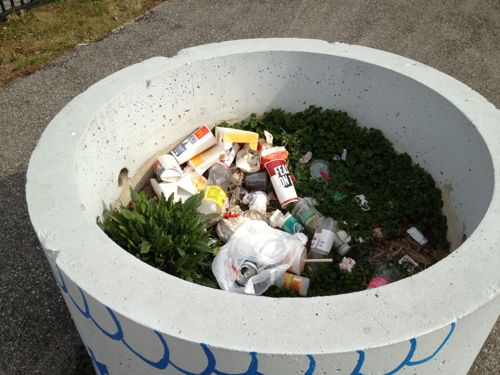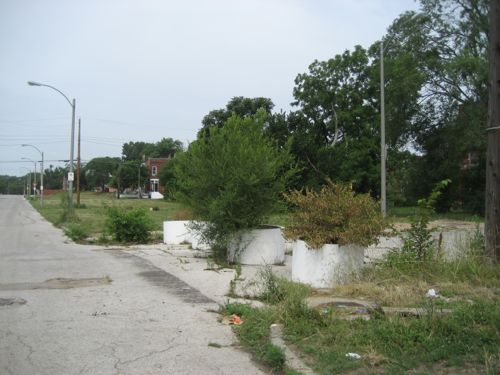‘Schoemehl Pots’ Need To Be Maintained Or Removed
When I voted last week I walked by this pot in the center of a walkway near 10th Street, next to Henry School. The walkway was once a public street.

Attractive huh? I’m sure these have a proper name but I’ve always liked the term “Schoemehl Pot,” a name based on their use starting during the administration of former mayor Vincent Schoemehl.

Most often they are used to destroy our street grid. Sometimes they are planted nicely but most often I see them full of trash, weeds, or both. In these cases they are not a positive part of the community but just another symbol of failed urban policies.
I’d like to see a study done of how many of these are scattered around the city and in what condition they are in. Just like broken windows or boarded up buildings, these foster negative behavior. I’d like to many, if not most, removed.
 – Steve Patterson
While I’d like to see them removed where they’ve “destroy[ed] our street grid”, I’d also argue that their condition reflect how local residents respect (or not) their neighborhoods. I’m not sure that “Just like broken windows or boarded up buildings, these foster negative behavior”. I’d argue that their neglect and abuse reflect how local residents accept “broken windows”, “boarded up buildings” AND weed-filled, graffitti-covered concrete bollards as a normal part of everyday life. In the Lindenwood Park area (where I live) we don’t have a lot of these, but they’re clean and maintained. I doubt that that’s solely the city’s doing; I’m guessing that the adjacent residents also work at keeping them looking presentable, much like how local residents work hard to keep our local park looking good, as well. The biggest problem with the ones you picture is that there appear to be no neighbors, no one who really cares, no one to pick up the trash, pull the weeds and/or to bug the city about it – they’re just another “boarded-up building”.
While I’d like to see them removed where they’ve “destroy[ed] our street grid”, I’d also argue that their condition reflect how local residents respect (or not) their neighborhoods. I’m not sure that “Just like broken windows or boarded up buildings, these foster negative behavior”. I’d argue that their neglect and abuse reflect how local residents accept “broken windows”, “boarded up buildings” AND weed-filled, graffitti-covered concrete bollards as a normal part of everyday life. In the Lindenwood Park area (where I live) we don’t have a lot of these, but they’re clean and maintained. I doubt that that’s solely the city’s doing; I’m guessing that the adjacent residents also work at keeping them looking presentable, much like how local residents work hard to keep our local park looking good, as well. The biggest problem with the ones you picture is that there appear to be no neighbors, no one who really cares, no one to pick up the trash, pull the weeds and/or to bug the city about it – they’re just another “boarded-up building”.
I agree. Ultimately removal is the goal. In the mean time the city doesn’t have the resources (unfortunately) to keep these things beautiful year round automatically. That said, like in other neighborhoods, if local residents took the initiative they could likely get free flowers from Brightside and have the rubbish removed with a phone call.
They are not very attractive and are, from a purist preserve-the-street-grid perspective, undesirable, but they do serve a practical purpose in calming traffic. The ones in my neighborhood are painted, planted with flowers, and weeded by residents taking the initiative to make them somewhat more appealing.
Traffic calming slows traffic but allows it to continue, the way these are used traffic is diverted onto arterial roads that we often want to be pedestrian-friendly commercial districts. We can’t have it both ways. We need to use curb bulbs and other techniques to slow traffic rather than just force it somewhere else.
They look like industrial trashcans. I will not blame the folks who are stuck in these (mostly) race-corraling one-end streets in the City. The larger point is that the majority of these inept, ill-conceived barricades NEED TO BE REMOVED and the street grid restored!
They look like industrial trashcans. I will not blame the folks who are stuck in these (mostly) race-corraling one-end streets in the City. The larger point is that the majority of these inept, ill-conceived barricades NEED TO BE REMOVED and the street grid restored!
My guess is the cost of maintaining these crumbling concrete waste-pots can’t be much different than what they started doing off Hampton ave in STL Hills, which is removing one or two of them and creating a bump-out with grass ( I assume to slow traffic or force a ‘no left turn’ etc) The result is a MUCH more pleasing landscape (or streetscape), it maintains the street grid by allowing one or two lanes access and creates a bit of safety for peds!
My guess is the cost of maintaining these crumbling concrete waste-pots can’t be much different than what they started doing off Hampton ave in STL Hills, which is removing one or two of them and creating a bump-out with grass ( I assume to slow traffic or force a ‘no left turn’ etc) The result is a MUCH more pleasing landscape (or streetscape), it maintains the street grid by allowing one or two lanes access and creates a bit of safety for peds!
Can you give an example of an intersection? I’m curious.
Lindenwood & Chippewa – just east of AT&T & Qdoba – the city rebuilt the intersection after a pedestrian was killed. In this case, the drums were installed to see if the lane realignment would improve safety; one it was proven to be an improvement, permanent changes were made, with new curbs.
When these concrete barriers are used to mock up a potential permanent change, they make sense (like along Grand). When they become the solution, as illustrated here, not so much. And, as with any city infrastructure investment, maintenance needs to part of any decision. Either the neighbors need to volunteer or the city needs to spend scarce resources to keep things looking good!
I can’t agree with you more. Â They’re absolutely ugly. Â However, on our block they seem to serve another purpose (beside garbage containing); that is, to slow the the big dummies who drive their cars too fast down our heavily residential street.Â
 http://superette.blogspot.com/2010/03/and-then-there-were-three.html
 http://superette.blogspot.com/2011/11/not-again.html
I can’t agree with you more. They’re absolutely ugly. However, on our block they seem to serve another purpose (beside garbage containing); that is, to slow the the big dummies who drive their cars too fast down our heavily residential street.
http://superette.blogspot.com/2010/03/and-then-there-were-three.html
http://superette.blogspot.com/2011/11/not-again.html
I agree.  Ultimately removal is the goal.  In the mean time the city doesn’t have the resources (unfortunately) to keep these things beautiful year round automatically.  That said, like in other neighborhoods, if local residents took the initiative they could likely get free flowers from Brightside and have the rubbish removed with a phone call.Â
They are not very attractive and are, from a purist preserve-the-street-grid perspective, undesirable, but they do serve a practical purpose in calming traffic. The ones in my neighborhood are painted, planted with flowers, and weeded by residents taking the initiative to make them somewhat more appealing.
Traffic calming slows traffic but allows it to continue, the way these are used traffic is diverted onto arterial roads that we often want to be pedestrian-friendly commercial districts. We can’t have it both ways. We need to use curb bulbs and other techniques to slow traffic rather than just force it somewhere else.
Steve, you may not remember this, but many were put in place to deter drug traffic by closing street access. I agree, they are hideous and if not maintained, should be removed.
Steve, you may not remember this, but many were put in place to deter drug traffic by closing street access. I agree, they are hideous and if not maintained, should be removed.
That’s true…you see this all over Forest Park Southeast (Grove).
And in the Grove, they were at least partly successful, according to a long time resident.
That’s true…you see this all over Forest Park Southeast (Grove).
And in the Grove, they were at least partly successful, according to a long time resident.
Have you seen the latest installation? On Clayton, west of Skinker, where the city has allowed the Cheshire Inn to take over the public right of way for additional parking. Hopefully this isn’t the “final answer”.
Have you seen the latest installation? On Clayton, west of Skinker, where the city has allowed the Cheshire Inn to take over the public right of way for additional parking. Hopefully this isn’t the “final answer”.
Can you give an example of an intersection? I’m curious.
Lindenwood & Chippewa - just east of AT&T & Qdoba - the city rebuilt the intersection after a pedestrian was killed. In this case, the drums were installed to see if the lane realignment would improve safety; one it was proven to be an improvement, permanent changes were made, with new curbs.
When these concrete barriers are used to mock up a potential permanent change, they make sense (like along Grand). When they become the solution, as illustrated here, not so much. And, as with any city infrastructure investment, maintenance needs to part of any decision. Either the neighbors need to volunteer or the city needs to spend scarce resources to keep things looking good!